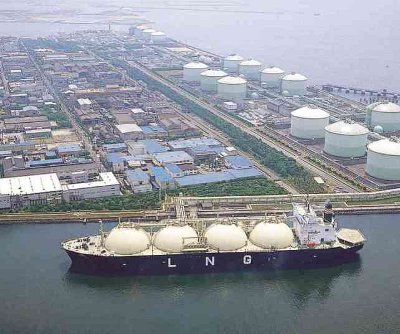As of Wednesday, a fourth liquefied natural gas (LNG) export terminal has been authorized by the Department of Energy to begin shipping natural gas to non-FTA (free trade agreement) sanctioned nations.
It was only ten years ago when there was worry that the U.S. would need to import gas to meet energy demands. Today, a complete turnabout sees domestic production booming and even creating a heavy debate about how the U.S. should handle its natural gas reserves.
 Now there are dozens vying for the opportunity to send the gas abroad.
Now there are dozens vying for the opportunity to send the gas abroad.
This latest approval for Dominion Resources, Inc.’s (NYSE: D) terminal comes just five weeks after a joint venture between Southern Union Co. (NYSE: SUG) and BG Group (LSE: BG) received Department of Energy (DOE) approval to export LNG from the Lake Charles, Louisiana terminal.
The DOE has picked up the pace of these approvals, and the potential for more approvals seems imminent before year’s end. And maybe it has a little something to do with a record forecast for domestic natural gas production in 2013.
But skeptics are still left with worry, warning that the U.S. risks losing its economic advantages as it continues to process more and more LNG export projects. This, they say, would eventually harm both consumers and businesses.
U.S. Approved
Dominion’s permit, which would allow it to export LNG from its Cove Point terminal on Maryland’s Chesapeake Bay, is conditional on meeting required regulatory approvals.
If and when that happens, construction would begin in 2014, according to TimesDispatch, for the new facility that would cost between $3.4 billion and $3.8 billion and begin service in 2017.
Dominion already has two major international customers in line to take some of the project’s export capacity. A 20-year terminal service agreement has been reached with Pacific Summit Energy LLC, a U.S. affiliate of Japanese trading company Sumitomo Corp. (OTC: SSUMY), and GAIL Global (USA) LNG LLC, a U.S. affiliate of GAIL (India) Ltd. (NSE: GAIL), according to TimesDispatch.
The terminal would export 770 million cubic feet of natural gas per day.
Further approval by the Federal Regulatory Commission will not come easily. Environmentalists will swarm the permit process and bring high contention to the matter.
It is far from over. Both local and global environmental groups will charge that the terminal will damage the Chesapeake Bay and the economy of the region, as well as raise global concerns over carbon dioxide emissions.
Dominion’s Cove Point is the fourth installment to be granted a permit by this administration, and it is the third to come this year after an almost two year hiatus, where applicants were under review to export gas.
Cheniere’s (NYSE: LNG) Sabine Pass Terminal, the firs granted approval in 2011, was also part of two studies commissioned by the DOE to weigh the economic impact of exports.
The studies gave a green light to LNG exports, and now the DOE is on a torrent pace of approvals. Three months passed between the decisions to permit Freeport LNG’s Quintana Island, Texas terminal and the Lake Charles terminal, passed on August 7.
And now, after Cove Point filed its application in 2011, it too has been approved.
Next!
The Industry & You
The natural gas industry, while stronger than ever in the U.S., is not without its share of opposition. Exporting alone gets a brunt of the blow from naysayers like Dow Chemical (NYSE: DOW), who argues that exports stunt a resurgence to U.S. manufacturing and squash our current hold on cheap gas prices.
The Sierra Club has already sued Dominion over its Cove Point terminal, siting a settlement in 1972 with Cove Point’s previous owners over how the facility can be used.
Environmentalists in general are pulling out all the stops on LNG, but it’s proving to be no deterrent to producers or even the DOE.
It’s clearly been decided that exporting vast natural gas reserves is in the public’s best interest. You can slow it down, but you’re not going to stop it.
The DOE does acknowledge that with its fourth approved terminal, it does cross a 6 billion cubic feet a day threshold it used in its commissioned reviews.
To address these concerns, the approval process may slow up at year’s end to consider new information provided by the Energy Information Administration on its outlook for 2014.
That still leaves enough time to approve three more projects if it continues on its current pace.
Next up: an expansion of Freeport LNG’s terminal, Sempra’s (NYSE: SRE) Cameron LNG project, and Veresen Inc’s (TSX: VSN) Jordan Cove project.
Our analysts have traveled the world over, dedicated to finding the best and most profitable investments in the global energy markets. All you have to do to join our Energy and Capital investment community is sign up for the daily newsletter below.
Making Moves
I can’t say for certain how fast these permit approvals will be granted, but they are likely to continue at monthly increments until year-end, or maybe even faster.
The U.S. needs to seize its opportunity to become a major factor in global gas trade, and it looks like that is finally becoming a realization.
Cove Point alone should add upwards of 20 cents per share for Dominion stockholders as it nears readiness for 2017.
The whole country is being set up to prosper as a result of the moves that are taking place today; thousands of jobs will be created, revenues will shoot up, and if we can get the environmentalists off our backs, then they too will see the upside to LNG exports. Okay, maybe that’s a stretch, but you’ll see…
Dominion has its infrastructure already in place, and it is set to exploit one of America’s richest shale gas regions: the Marcellus shale.
Get ready for a busy fourth quarter in natural gas.
If you liked this article, you may also enjoy:




